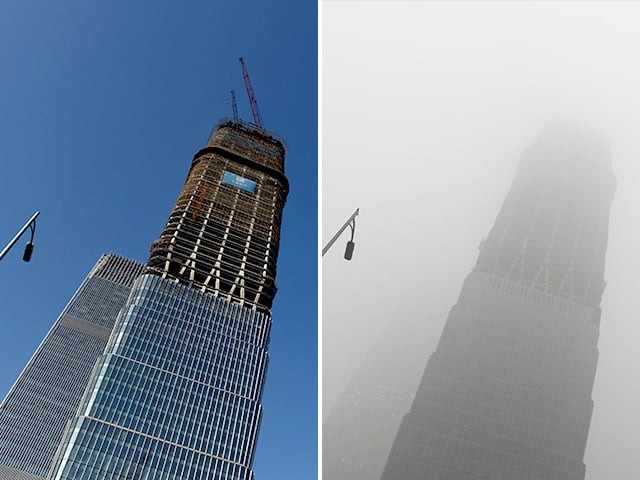China pollution pledge hopes to soothe smog fears: analysts
China announces plans to reduce by 60% the amount of major pollutants coming from its coal-fired power plants by 2020

This combination image of two photographs taken on December 3, 2015 (L) and two days earlier on December 1 (R) shows a skyscraper under clear skies and in heavy pollution, as seen in the central business district in Beijing. PHOTO: AFP
With negotiating teams locked in crucial talks in Paris, China's state council announced plans to reduce by 60 per cent the amount of "major pollutants" coming from its coal-fired power plants by 2020.
China smog at crippling levels as climate talks open
That should save around 100 million tonnes of raw coal and cut carbon dioxide emissions by 180 million tonnes annually, it said on its website. The statement did not, however, specify which pollutants will be cut, and gave no baseline against which the reduction will be measured.
But observers said "major pollutants" likely refers to the particulate matter that makes up the choking smog that has blanketed swathes of China over the past week — many of which are not considered direct drivers of global warming.
China is the world's biggest emitter of the greenhouse gases that cause climate change, and a crucial player in this month's global gathering in Paris, where nations are trying to thrash out a plan to limit dangerous global warming.
But a 180 million tonnes annual cut in carbon emissions is a drop in the ocean for an economy that produced nine- to ten billion tonnes of carbon dioxide in 2013 — nearly twice what the United States generated.
Rich blamed as world seeks climate pact
Likewise, a 100 million tonne reduction of raw coal consumption would represent about two per cent of China's annual use, which hit 4.2 billion tonnes in 2013.
As well as carbon dioxide, that coal burning is a major source of the acrid smog that frequently blankets stretches of the country, causing health problems and reducing visibility for tens of millions of people in China's densely-populated cities.
Beijing and parts of northern China this week were enveloped in a soup of dangerous particulates that in places reached more than 25 times the level considered safe for humans to breathe.
The government reacted by ordering factories to shut as they raced to clear the air and assuage growing public anger that the Communist Party recognises is a threat to its authority.
"Reducing smog in Chinese cities is an imperative for the government," Lin Boqiang, director of the Energy Economics Research Centre at Xiamen University, told AFP. "It's convenient that the announcement came during the Paris conference, but it's more about fighting smog and air pollution."
Greenpeace says Beijing has approved the construction of 155 new coal-burning power plants so far this year already. Wednesday's announcement means that number will likely grow as more plants are brought online to plug the gap left by the shuttering of older, dirtier power stations.
It all leaves China with something of a conundrum: squaring its need to produce enough power with its promise to reduce coal's contribution to the energy mix to below 65 per cent by 2017, down from approximately 70 per cent currently.
World's richest 10 per cent produce 50% of CO2: report
At the COP 21 summit in Paris this week, President Xi Jinping repeated a pledge that emissions would peak by "around 2030".
But, says Greenpeace China's climate and energy campaigner Li Shuo, while the timing of Wednesday's announcement might have been propitious: "The background is Beijing had a very bad round of air pollution in these past two or three days".



















COMMENTS
Comments are moderated and generally will be posted if they are on-topic and not abusive.
For more information, please see our Comments FAQ